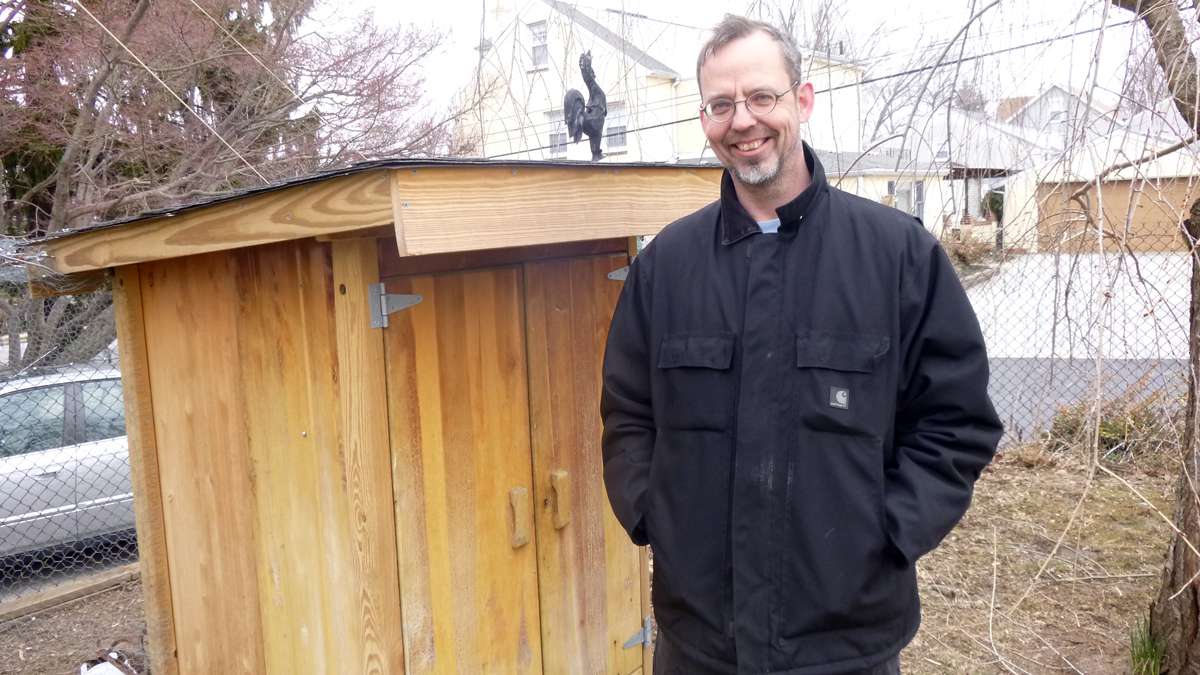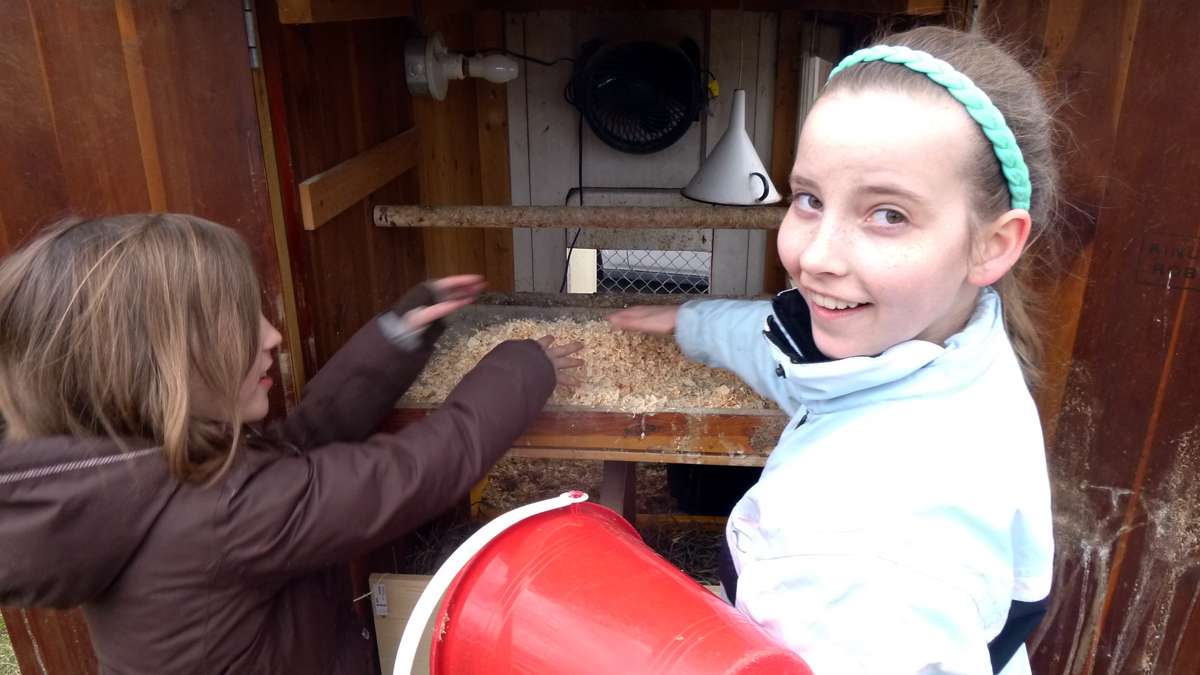Half of Pa. public schools fail to meet state’s expectations, new study says
-

It can be difficult to see in contrast to the sweater it is resting on, but Snuggles' egg is a delicate shade of blue-green, characteristic of the Ameraucana breed. (Jennifer Lynn/WHYY)
-

Ariadne Marg-Bracken, 13, with the chicken coop's watering trough. (Jennifer Lynn/WHYY)
-

Thilo Marg-Bracken, father, and builder of the coop, made of an old dresser and recycled hardware. (Jennifer Lynn/WHYY)
-

Marlena Marg-Bracken, 9, with Snuggles the chicken, who is blind in one eye and who lays beautiful bluish-green eggs. (Jennifer Lynn/WHYY)
-

Marlena Marg-Bracken, 9, (left) and her sister Ariadne, 13, freshen up the hens' bedding in the coop. (Jennifer Lynnn/WHYY)
-

A lone hen wanders the grounds of the Marg-Bracken flock in Bala Cynwyd, Pa.(Jennifer Lynnn/WHYY)
A new analysis from the Public Interest Law Center of Philadelphia finds 49 percent of Pennsylvania public schools fail to meet the state’s overall proficiency expectations.
PILCOP’s report centers on 2012-2013 state standardized test scores in reading and math – measuring student performance at all public schools, district, charter or otherwise.
Schools not meeting the state’s proficiency target are situated in 72 percent of Pennsylvania’s school districts, or 357 out of 499, the report said.
“This is a widespread problem,” said PILCOP attorney Michael Churchill. “I think there’s a popular image that a few distressed school districts are having these problems, and that, generally, the state is doing well, but that is not what this data shows.”
Beginning in 2013, the Pennsylvania Department of Education established target goals for the percentage of students who should score at proficient or advanced levels in reading/literature at 70 percent and in math/algebra at 73 percent.
Churchill admits that there is a limit to what a standardized test can tell you, but they do give an accurate portrait, he said, of which schools “are failing to meet minimum standards.”
Great expectations are costly
PILCOP contends that scores have lagged because the state hasn’t been willing to pay the cost of its expectations.
“This is a classic unfunded mandate,” said Churchill. “It’s relatively easy to get a small fraction of your students to pass, but to get a substantial number of your students [to pass] requires more resources than most of these districts have.”
The state’s students made progress on standardized test scores from 2003 through 2010, when education funding was boosted during Ed Rendell’s tenure as governor.
The trend reversed when Gov. Tom Corbett took office in 2011 and federal stimulus funding disappeared – causing funding earmarked for classroom education to shrink.
“The percentage of all students in the state scoring proficient and advanced on the PSSA/Keystone exams have been declining over the last three years as the exams have changed and as instructional funding has been cut,” says the report.
In 2011, 77 percent of students were proficient in math and 74 were proficiency in reading. In 2013, those figures dropped to 73 percent and 70 percent respectively.
Test score declines cannot, though, be tied solely to funding. As the state adopted the common core curricula and traded the PSSA for the Keystone exam in state public high schools, the tests themselves have become more difficult.
Finances, though, have also played a role in this transition.
The state claimed that districts would not incur additional costs based on the testing changeover. “That has proven, I think, to be quite hollow,” Churchill said.
“All the districts are reporting that it is costly for them to provide the remediation and the training necessary to help the students pass this test,” he continued.
As tests have become more difficult, Pennsylvania has significantly lowered its proficiency expectations. In 2011-12, the targets were 78 percent proficiency in reading, and 81 percent in math (compared with 70 and 73 percent this year).
If the 2011-12 goals were judged against the 2012-2013 results, 79 percent of schools would have missed the target.
“In assessing whether the state has a ‘thorough and efficient system of public education serving the needs of the Commonwealth,’ the critical factor,” the report concluded, “is whether students actually meet the standards which the state has deemed as showing an acceptable level of proficiency.”
State Sen. Andy Dinniman, D-Chester, didn’t mince words about PILCOP’s assessment.
“They’re right,” he said. “We aren’t meeting our obligation.”
Dinniman, minority chair of the Senate Education Committee, said the report confirms his belief that the state is underfunding the education of many students across Pennsylvania – specifically those from lower- and middle-class backgrounds.
“You do have about a third of the districts in the commonwealth that do very well,” Dinniman said. “These are usually districts that have an excellent tax base.”
The state Department of Education found the PILCOP report to be “very concerning,” in that it only looked at “static” test results.
“The concept that 49 percent of our schools are below the proficiency mark is kind of not telling the whole story,” said department spokesman Timothy Eller.
A better report, he said, would have utilized the state’s new School Performance Profile, which looks at metrics such as growth indices, attendance, and graduation rates in addition to static test score results.
Based on SPP scores, Eller said, 73 percent of public schools in the state are meeting the department’s benchmark (SPP score 70 or above).
Eller expects static test scores to rebound as schools grow in their comfortablity with the common core state standards and the Keystone exam.
Long view
Under Rendell, Pennsylvania implemented a funding formula in 2008 that took into account the number of students in each district, community poverty levels, percentage of English language learners and the local tax effort – allocating relatively more funding to districts that were larger, poorer, and had higher property taxes.
Rendell implemented the changes based on a 2007 costing-out study that aimed to determine the amount of resources schools needed to meet the state’s academic performance expectations.
The study found that the state needed to spend another $4.4 billion annually – $1 billion more in Philadelphia alone.
In an attempt to meet those figures, Rendell set out to increase the state’s basic-education contribution by $2.6 billion a year by 2014 – with the remainder of the money to be raised locally.
But when the Recession came, as state and local tax revenues dwindled, Rendell drew down state dollars and replaced them with federal stimulus funds in hopes of maintaining the trajectory of the goals he set forth based on the costing-out study.
By the time the newly elected Corbett was drafting his first budget in 2011, the federal stimulus funds were set to expire, and Corbett declined to increase taxes as a way of making up the difference.
As a result, in Rendell’s last year as governor, the state sent about $6.3 billion (including stimulus funding) to public school classrooms. In Corbett’s first year as governor, the state sent about $5.3 billion.
With stimulus funding gone, Corbett has increased the state’s contribution to the basic education subsidy by $1.17 billion (while, at the same time, cutting hundreds of millions of dollars from other education-related budget line-items).
Corbett’s proponents say it was foolhardy for Rendell to rely on one-time revenues from the stimulus for recurring expenses.
In a past correspondence, education department spokesman Eller defended Corbett’s education record. “Unfortunately, traditional public education establishment organizations continue to misinform the public about the governor’s record of education funding in Pennsylvania,” he wrote.
Corbett’s critics say it’s disingenuous to trumpet education-funding increases when the overall amount of funding that classrooms receive hasn’t recovered, and the formula for doling out those funds has been revoked.
At this point, basic education funds are allocated by the state Legislature without any predictable, data-driven decision processes guiding the methodology.
The Corbett administration admits that this is a problem, and has supported the creation of a commission to study the implementation of a new formula.
WHYY is your source for fact-based, in-depth journalism and information. As a nonprofit organization, we rely on financial support from readers like you. Please give today.


